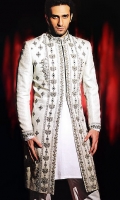Mens Sherwani Definition
Source(Google.com.pk)
Nihal Fashions announces the new arrival of Men’s Sherwani, Indo Western clothes and kurta pajama.
Nihal
Fashions in one of the best online store for traditional and ethnic
Indian clothes. They are committed to provide you the finest traditional
garments. Their exquisite collection of product line includes mens
sherwani, kurta pajama, dhoti, indo western suits, salwar kameez,
sarees, lehenga choli, kids kurta pajama and sherwani.
They pay
the closest attention to every detail including jewels, gemstones,
sequins and zari work. Their garments exhibit Indian traditional style
and customs, with an aesthetic blend of modern and ethnic look. Along
with this, they also offer various discount coupon codes at their
website.
Sonal Chaudhary, Proprietor of Nihal Fashions states
that, “A brand new collection of mens sherwani, indo western clothes and
kurta pajamas is added to the Nihal Fashions website. All these
designer products are available in vibrant colors and beautiful
designs.”
Nihal Fashions is one stop online store for designer
and traditional Indian outfits and wedding dresses. Their marvellous
collection of Indian ethnic apparels is exclusively designed for Indian
wedding and traditional functions. Their extensive product line covers
mens sherwanis, kurta pajama, lehenga choli, sarees, traditional sarees,
cotton salwar kameez and more.The sherwani or achkan, with karakul hat is the recommended dress for male government employees and officials, as it is not specifically associated with any of the provinces. Most male government officials wear the formal black sherwani on state occasions.
A large Pakistani diaspora exists in the Western world and the Middle East. Whereas Pakistanis in the United States, Canada and Australia tend to be professionals, the majority of them in the United Kingdom, Germany and Scandinavia originally came from a rural background belonging to the working class. These emigrants and their children influence Pakistan culturally and economically, keeping close ties with their roots by travelling to Pakistan and especially by returning or investing there.See also: Economy of PakistanPakistani girl in Mehndi Function wearing traditional Pakistani dress
Pakistan's service sector accounts for 53% of the country's gross domestic product. Wholesale and retail trade is 30% of this sector. Shopping is a popular pastime for many Pakistanis, especially among the well-to-do and the thirty-million strong middle class. The cities of Lahore, Karachi, Peshawar, Islamabad, Faisalabad, and Quetta are especially known for the great contrast in shopping experiences from burgeoning bazaars to modern multi-story shopping malls. In particular, Lahore and Karachi are peppered with colourful shopping plazas. Over 1,081 patent applications were filed by non-resident Pakistanis in 2004.
Pakistanis have evolved an often distinct and unique set of culture, traditions and customs in the region. Shalwar Qameez is the dress commonly worn, both by men and women, and Kashmiru, etc. put and dances are distinctly unique with their own melodies, instruments, patterns and styles. Pakistani arts in metal work, tiles, furniture, rugs, designs/paintings, literature, calligraphy, and much more are diverse and renowned internationally. Pakistani architecture is unique with its infusion of Islamic, Persian, Turkish and Indigenous styles. The manners and lifestyles are guided by a blend of traditions as well as the culture. Food dishes are also attracting quite a lot of attention with its wide blend of flavours and spices
This article has multiple issues. Please help improve it or discuss these issues on the talk page.
This article is written like a personal reflection or opinion essay rather than an encyclopedic description of the subject. (March 2013)
This article may contain original research. (March 2013)
This article does not cite any references or sources. (March 2013)
The vast majority of Pakistanis are Caucasoid by race[citation needed][dubious – discuss] but many other distinct minority are also present. The majority of Pakistanis are of average to above average height.[dubious – discuss] Pakistan is notable for having several individuals in the Guinness Book of World Records, such as Alam Channa for the tallest man in the world. Pakistanis are diverse, many possessing dark hair and eyes but light coloured eyes and light coloured hair do occur in significant portions of the population as well, notably in the North amongst the Dardic, Kalash, Burusho, Wakhi, and north western Pashtun tribes. The typical Pakistani can range from light to dark brown skin tones with a few exceptions in mountainous regions of the north. Many of the people inhabiting Pakistan's western regions share genetic affinities with ethnic groups in Iran, Afghanistan and Tajikistan[dubious – discuss][citation needed]. While the racial features of each ethnic group in Pakistan are not uniform, Chitralis and some of the Dardic tribes in the north are the most Caucasoid phenotypically, followed by the Pashtuns (also known as Pakhtuns), Kashmiris, Paharis/Potoharis, Balochis, Punjabis, and Sindhis, Muhajirs, and Seraikis. The Negroid people live along the Makran coast and are a small minority known as the Sheedi who came from East Africa in the 15th century. Panjabis, Seraiki and The Sindhis have considerable admixture and show a diverse phenotypic features representative of their multicultural history.[dubious – discuss] The Mongoloid people also inhabit Pakistan are of Central Asian origin where oftentimes their racial elements are infused within the dominant Caucasoid genes of the vast majority of Pakistanis, however there are many instances in which some have retained their distinct racial characteristics. Pakistan's genetic diversity is due to various factors including the numerous waves of migration from other regions[dubious – discuss][citation needed] and include Aryans mainly, in smaller amounts Greeks, Iranians, Arabs, Turks, Scythians, Afghans to name a few and also because of its geopolitical location straddling the Iranian Plateau.
Mens Sherwani
 |
Mens Sherwani |
 |
Mens Sherwani |
 |
Mens Sherwani |
 |
Mens Sherwani |
 |
Mens Sherwani |
 |
Mens Sherwani
|




No comments:
Post a Comment